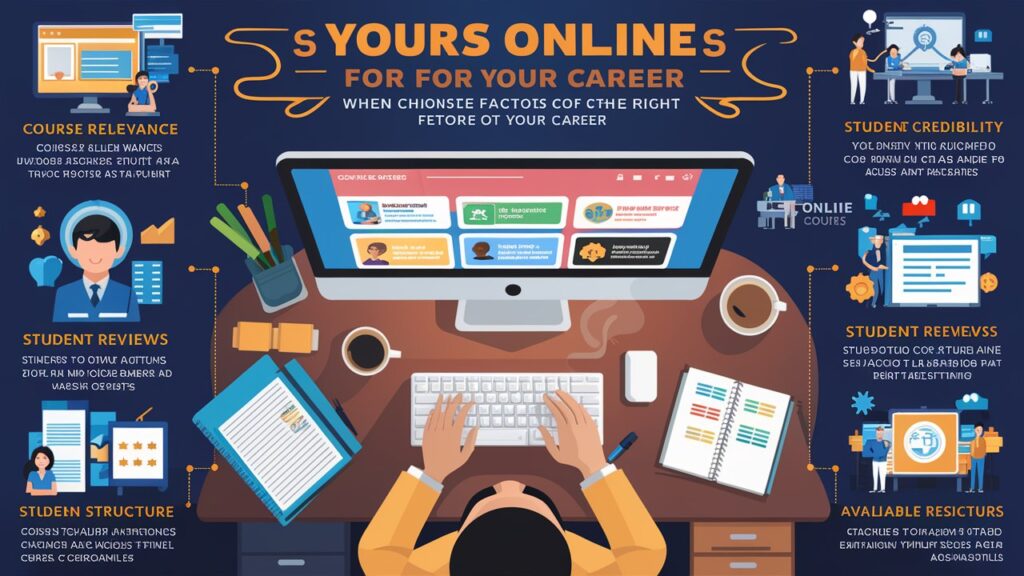In today’s digital age, online courses have become a popular way for individuals to advance their careers. With countless options available, selecting the right course is crucial to achieving your career goals. This article will guide you through on how to choose the right online course for your career.
1. Assess Your Career Goals
The first step in choosing the right online course is to clearly define your career goals. Identify your long-term and short-term objectives and understand the specific skills and knowledge you need to acquire. This will help you narrow down the courses that align with your desired career path.
Begin by reflecting on where you see yourself in the next few years. Are you aiming for a promotion, a career switch, or enhancing your expertise in your current field? Knowing your career goals will provide a clear direction and make it easier to choose the most relevant online courses.
Next, break down these goals into specific skills and knowledge areas you need to develop. For example, if your goal is to move into a management position, you might need to learn about leadership, project management, and communication. Alternatively, if you’re looking to enter a new field like data science, you’ll need to focus on acquiring knowledge in statistics, programming, and data analysis.
Create a list of these required skills and knowledge areas. This list will serve as a guide when you start researching online courses. Look for courses that specifically address these requirements and can help you bridge the gap between your current abilities and your career goals.
Moreover, consider any industry certifications that are valued in your target career. Certifications can significantly enhance your resume and demonstrate your commitment to professional growth. Identify the certifications relevant to your career goals and seek out online courses that offer these credentials.
2. Research Available Courses
Explore various learning platforms such as Coursera, Udemy, and LinkedIn Learning. Look for courses that align with your career goals and meet your skills requirements. Consider the reputation and credibility of the course providers to ensure you receive high-quality education.

Start by searching for courses in your field of interest and compare their offerings. Examine the course content to ensure it covers the necessary topics to help you achieve your career goals. Pay attention to the skills and knowledge each course aims to develop.
It’s also important to read reviews and testimonials from past students. This feedback can provide insights into the course content, the effectiveness of the instructors, and the overall learning experience. Look for courses that consistently receive positive feedback and high ratings.
Additionally, consider the structure and delivery format of the course. Some courses are self-paced, allowing you to learn at your own speed, while others follow a fixed schedule. Choose the format that best suits your learning style and schedule.
Don’t forget to evaluate the cost of the courses. While some high-quality courses might be more expensive, they can offer a better return on investment (ROI) in terms of career advancement. Look for any available scholarships, discounts, or financial aid options to help manage the financial investment.
3. Evaluate Course Content and Structure
Carefully review the syllabus and course content. Ensure the topics covered are relevant to your career goals. Determine if the course offers practical assignments, projects, or case studies that can help you apply the knowledge you gain.
Start by examining the syllabus to understand the overall structure and flow of the course. A well-organized syllabus will give you a clear idea of what to expect from the course and how it aligns with your career goals. Check if the course content is up-to-date and covers the latest trends and developments in your field.
Look for detailed descriptions of each module or section. This will help you assess whether the course content matches the skills and knowledge you need to acquire. For example, if you’re looking to enhance your project management abilities, the course should cover essential topics like project planning, risk management, and stakeholder communication.
Evaluate the depth and breadth of the course content. Ensure it provides a comprehensive understanding of the subject matter without being too superficial. Courses that include a variety of learning materials, such as videos, readings, and interactive elements, can cater to different learning styles and enhance your understanding.
Assess the types of assessments and assignments included in the course. Practical assignments, projects, and case studies are crucial for applying the theoretical knowledge you gain. These hands-on components can significantly enhance your learning experience and prepare you for real-world applications in your career.
Consider the duration and intensity of the course. Ensure it fits within your schedule and allows you to balance your studies with other commitments. Some courses offer flexible schedules, while others may require a more intensive time commitment. Choose a course structure that aligns with your availability and learning preferences.
Additionally, investigate if the course provides opportunities for peer interaction and feedback. Engaging with other learners through discussions, group projects, or forums can enrich your learning experience and provide different perspectives on the course material.
Verify if the course offers any supplemental resources or support, such as access to additional readings, webinars, or one-on-one coaching. These resources can provide extra value and enhance your overall learning experience.
4. Instructor Credentials and Experience
Research the background and expertise of the instructors. Look for instructors with industry experience and a strong academic background. Credentials and experience are crucial in ensuring you receive valuable insights and knowledge.
Start by examining the instructors‘ professional background. Look for information about their education, work experience, and any notable achievements in their field. Instructors with a combination of academic qualifications and practical industry experience can provide a balanced and comprehensive learning experience.
Check the instructors‘ profiles on the course platform or their LinkedIn profiles to gather more details about their career trajectory and expertise. Look for evidence of their involvement in relevant projects, publications, or contributions to their industry. An instructor who actively participates in their field is likely to provide current and relevant knowledge.
Consider the instructors‘ teaching experience. Experienced teachers are often better at explaining complex concepts clearly and engaging students. Look for instructors who have taught similar courses before or have received positive feedback from previous students.
Read reviews and testimonials from past students specifically about the instructors. Positive reviews can indicate that the instructor is knowledgeable, approachable, and effective in delivering the course content. Conversely, negative feedback might highlight potential issues with the instructor’s teaching style or availability.
Look for instructors who provide additional support and resources outside the main course material. This can include live Q&A sessions, office hours, discussion forums, or personalized feedback on assignments. Such support can significantly enhance your learning experience and provide you with more opportunities to clarify doubts and deepen your understanding.
Check if the instructors are affiliated with reputable institutions or organizations. This can add to their credibility and ensure that the knowledge they impart is aligned with industry standards and best practices.
Additionally, consider if the instructors are involved in ongoing professional development. Instructors who continuously update their skills and knowledge are more likely to teach up-to-date and relevant content. Look for evidence of their participation in workshops, conferences, or additional certifications.
Consider reaching out to the instructors directly if possible. Many instructors are open to answering prospective students’ questions about the course. This can give you a sense of their responsiveness and willingness to engage with students.
5. Course Format and Flexibility
Determine if the course is self-paced or has a fixed schedule. Assess the time commitment required and ensure it fits into your schedule. Consider if the course offers lifetime access to materials or has a limited access period, providing you with the flexibility to learn at your own pace.

Start by identifying the type of course format that suits your learning style and schedule. Self-paced courses allow you to progress through the material at your own speed, which is ideal if you have a busy or unpredictable schedule. This format offers the ultimate flexibility, enabling you to balance your studies with work, family, and other commitments.
On the other hand, courses with a fixed schedule can provide a more structured learning experience. These courses often include set deadlines for assignments and exams, which can help you stay motivated and on track. If you thrive under a more regimented learning environment, a fixed schedule course might be more suitable.
Evaluate the total time commitment required for the course. Check the estimated hours per week you need to dedicate to studying, attending lectures, completing assignments, and participating in discussions. Ensure that this time commitment is manageable within your current lifestyle and responsibilities.
Consider the duration of the course. Some courses are designed to be completed in a few weeks, while others may span several months. Determine how the course duration fits with your career goals and how quickly you need to acquire the new skills and knowledge.
Another important factor is the availability of course materials. Some online courses offer lifetime access to the content, which allows you to revisit the material anytime you need a refresher. This can be particularly beneficial for retaining knowledge and applying it in your career over the long term. Alternatively, some courses have a limited access period, which requires you to complete the course within a set timeframe. Choose the option that best aligns with your learning needs and future plans.
Check if the course includes any live sessions, webinars, or interactive components. Live sessions can provide opportunities for real-time interaction with instructors and peers, enhancing your learning experience. However, consider the scheduling of these sessions and whether you can attend them without conflicting with other commitments.
Assess the level of support provided throughout the course. Self-paced courses may offer less direct support, while courses with fixed schedules often include more structured interaction with instructors and fellow students. Determine if the support level meets your learning preferences and needs.
Furthermore, investigate the technological requirements for the course. Ensure you have access to the necessary hardware and software, and check if the course platform is user-friendly and reliable. Technical issues can hinder your learning experience, so it’s essential to be well-prepared.
6. Accreditation and Certification
Check if the course is accredited by a recognized institution or organization. Understand the value of the certification provided upon completion. Accredited courses and recognized certifications can significantly boost your resume and career prospects.
Start by investigating whether the online course is accredited. Accreditation is a process where an external body evaluates the course to ensure it meets specific quality standards. Courses accredited by reputable institutions or organizations are generally more credible and respected in the industry. Examples of accrediting bodies include universities, professional associations, and industry-specific organizations.
Accreditation can have a significant impact on your career goals. Employers often prefer candidates with credentials from accredited programs because it assures them that the education received meets high standards. Additionally, some professional certifications and licenses require completing accredited courses as a prerequisite.
Next, understand the value of the certification you will receive upon completing the course. Research how the certification is perceived in your industry. Look for evidence that it is recognized and respected by employers, peers, and professional organizations. Certifications from well-known platforms or institutions can enhance your resume and make you more competitive in the job market.
Consider how the certification aligns with your career goals. If you are looking to advance in your current field, ensure the certification covers the relevant skills and knowledge needed for higher-level positions. For those switching careers, the certification should provide foundational knowledge and skills that are crucial for your new career path.
Evaluate the certification process. Some courses require passing exams, completing projects, or meeting other requirements to earn the certification. Understand what is expected and assess whether you are prepared to meet these requirements. The rigor of the certification process can also impact its value and credibility.
Additionally, investigate if the certification provides any ongoing benefits. Some certifications require renewal through continuous education or professional development, ensuring that your knowledge remains current. Others might offer access to professional networks, exclusive resources, or career services that can support your career growth.
Check if the course platform provides verifiable certificates. Verifiable certificates can be shared on professional networks like LinkedIn, added to your resume, or presented to potential employers. They often come with unique identifiers or digital badges that validate your achievement and make it easier for others to verify the authenticity of your certification.
Look for courses that offer additional support in obtaining and utilizing your certification. This might include guidance on how to showcase your certification on your resume, advice on leveraging it for career advancement, or even job placement assistance.
More so, consider if the certification aligns with any industry standards or frameworks. Certifications that adhere to recognized standards can provide a common language and set of expectations that employers understand and value. This can be particularly important in fields like IT, healthcare, project management, and finance.
7. Reviews and Testimonials
Read reviews and testimonials from past students to gauge the quality of the course. Look for both positive and negative feedback to get a balanced view. Consider reaching out to alumni for firsthand insights into the course’s effectiveness and relevance.
Start by searching for reviews on the course platform and other educational review sites. Reviews can provide valuable insights into the course content, instructors, and overall learning experience. Pay attention to patterns in the feedback to identify common strengths and weaknesses.
Positive reviews often highlight the course’s strengths. Look for comments about the clarity and organization of the course content, the expertise and engagement of the instructors, and the practicality of the assignments and projects. Positive feedback on these aspects indicates that the course is well-designed and effectively meets the learning needs of students.
Negative reviews can also be informative. They can point out potential issues such as outdated materials, technical problems with the learning platform, or lack of instructor support. Understanding these potential drawbacks can help you weigh the pros and cons of enrolling in the course. Look for responses to negative feedback from the course provider, as this can indicate their commitment to improving the course and addressing student concerns.
Testimonials are another valuable source of information. Many course platforms feature testimonials from students who have successfully completed the course. These often highlight personal experiences and the impact the course has had on their careers. Testimonials can provide inspiration and help you envision how the course might benefit your own career goals.
Consider the diversity of the reviews and testimonials. Feedback from students with different backgrounds and career paths can provide a more comprehensive view of the course’s applicability and effectiveness. This diversity can be especially useful if you are considering a course that is not strictly aligned with your current field but aims to broaden your skills and knowledge.
Reach out to alumni if possible. Connecting with past students directly can provide deeper insights and allow you to ask specific questions about their experiences. Alumni can share details about the course content, the level of interaction with instructors, the relevance of the skills learned, and how the course has impacted their careers. Many alumni are willing to share their experiences and offer advice to prospective students.
Utilize social media and professional networks like LinkedIn to find and connect with alumni. Many educational institutions and course providers have dedicated groups or pages where current students and alumni interact. Joining these groups can give you access to a community of learners and additional perspectives on the course.
Additionally, check for independent reviews and ratings from educational review sites. Websites like CourseReport, Class Central, and Trustpilot often provide unbiased reviews and ratings from a broader audience. These platforms can help you compare different courses and make a more informed decision.
Consider the overall rating of the course but also delve into detailed reviews to understand the nuances of the feedback. A high overall rating is a good indicator of quality, but the detailed reviews will provide specific insights that are crucial for your decision-making process.
8. Cost and Financial Investment
Compare the costs of similar courses across different platforms. Evaluate the return on investment (ROI) in terms of career advancement. Look for scholarships, discounts, or financial aid options to help manage the financial investment.
Begin by researching the cost of the online courses you are interested in. Prices can vary significantly based on the platform, course length, and the depth of course content. Make a list of the courses that align with your career goals and compare their prices. This initial step will help you understand the market rate for the courses you are considering.
Consider the different pricing models offered by various learning platforms. Some platforms charge a one-time fee for lifetime access to a course, while others operate on a subscription basis, giving you access to multiple courses for a monthly or annual fee. Evaluate which pricing model offers the best value for your specific needs and budget.
It’s important to assess the overall value of the course content relative to its cost. Higher-priced courses might offer more comprehensive materials, access to expert instructors, and additional resources like practical assignments and projects. Ensure that the course content justifies the cost and that you are getting a high-quality education for your investment.
Evaluate the potential return on investment (ROI) of the course. Consider how the skills and knowledge gained from the course will impact your career goals. For example, if completing the course will help you secure a higher-paying job, a promotion, or new opportunities in a different field, the investment may be well worth it. Calculate the potential increase in earnings or career growth against the cost of the course to determine its ROI.
Look for any available scholarships, discounts, or financial aid options. Many online learning platforms and educational institutions offer financial assistance to help students afford their courses. Check the course provider’s website for information on available scholarships or discounts for early registration, bulk purchases, or referrals. Some platforms also offer discounts to members of certain professional organizations or alumni of specific institutions.
Investigate employer-sponsored learning programs. Some employers provide financial support for their employees to pursue further education and professional development. Check with your HR department to see if your company offers tuition reimbursement or other financial incentives for taking online courses that are relevant to your job.
Consider free trials or money-back guarantees offered by some platforms. These options allow you to start the course and evaluate its content and quality before fully committing financially. If the course does not meet your expectations, you can opt out without incurring the full cost.
When comparing costs, also factor in any additional expenses that might arise, such as textbooks, software, or special equipment required for the course. These additional costs can add up and should be considered in your overall budget.
Examine the payment options provided by the course platform. Some platforms offer installment plans that allow you to spread the cost over several months, making it more manageable. Evaluate these options to find a payment plan that fits your financial situation.
Consider the long-term benefits of the course. Investing in your education can have lasting positive effects on your career and earning potential. A well-chosen course that enhances your skills and knowledge can open doors to new opportunities and significantly boost your professional growth.
9. Support and Resources
Check if the course provides access to additional resources such as forums, study groups, or mentorship. Determine the level of support available, including career services and technical support for platform-related issues. Access to a supportive community can enhance your learning experience.
Start by investigating the types of support the course offers. A well-supported course can significantly enhance your learning experience and help you better understand the course content. Look for features such as discussion forums, live Q&A sessions, study groups, and one-on-one mentorship. These resources can provide you with opportunities to ask questions, clarify doubts, and interact with peers and instructors.
Forums and discussion boards are valuable resources where you can engage with fellow students and share insights and experiences. Active participation in these forums can enhance your understanding of the material and provide different perspectives on the course content. Check if the course platform hosts vibrant and active forums, and if the instructors or course facilitators participate in these discussions to provide guidance and answer questions.
Study groups are another excellent resource that can foster collaborative learning. Joining or forming a study group allows you to work through challenging concepts with peers, share notes and resources, and provide mutual support. Look for courses that facilitate the formation of study groups or offer virtual meeting spaces for group activities.
Mentorship programs can be particularly beneficial, providing personalized guidance and feedback from experienced professionals. A mentor can help you navigate the course content, provide career advice, and support your skills development. Check if the course includes access to mentors or offers optional mentorship programs for an additional fee.
Assess the level of career services provided by the course. Some online courses offer career coaching, resume reviews, job placement assistance, and networking opportunities with industry professionals. These services can be invaluable in helping you translate your new skills and knowledge into career advancement opportunities. Research the specific career services offered and evaluate their potential impact on your career goals.
Technical support is another crucial aspect to consider. Ensure that the course platform provides reliable technical support to address any issues you might encounter with accessing materials, submitting assignments, or using interactive features. Look for platforms that offer 24/7 technical support or have a robust help center with comprehensive FAQs and troubleshooting guides.
Additionally, investigate if the course provides supplementary learning materials such as additional readings, video tutorials, practice exercises, and interactive simulations. These resources can enhance your learning experience and provide deeper insights into the course content. Access to a variety of learning materials can cater to different learning styles and help reinforce the concepts covered in the course.
Check if the course offers any real-world application opportunities, such as internships, live projects, or collaborations with industry partners. Practical experience is invaluable in solidifying your knowledge and skills and can significantly boost your resume. Courses that provide these opportunities often offer a more comprehensive and immersive learning experience.
Look for testimonials or reviews that mention the quality and availability of support and resources. Feedback from past students can give you an idea of how responsive and helpful the support services are and whether the additional resources significantly contributed to their learning experience.
Consider the overall community and networking opportunities provided by the course. Engaging with a community of like-minded learners and professionals can create valuable connections that extend beyond the course itself. Networking opportunities can lead to professional collaborations, job offers, and ongoing support throughout your career.
10. Trial Periods and Money-Back Guarantees
Look for courses that offer trial periods or money-back guarantees. Use trial periods to evaluate the course content and delivery style. Understanding the refund policies can provide you with peace of mind in case the course does not meet your expectations.
Start by identifying courses that provide trial periods. A trial period allows you to access the course for a limited time before committing financially. This can be an invaluable opportunity to experience the course content, teaching style, and platform usability firsthand. During the trial, pay close attention to whether the material is engaging, well-organized, and relevant to your career goals.
While using the trial period, evaluate the quality and clarity of the course content. Assess if the topics covered align with your learning objectives and whether the material is presented in a way that is easy to understand. Check if the instructors provide comprehensive explanations, examples, and additional resources to support your learning.
During the trial period, also explore the course’s interactive elements, such as quizzes, practical assignments, and discussion forums. Determine if these components enhance your understanding of the material and provide valuable opportunities to apply your knowledge. A course that actively engages you in the learning process is more likely to be effective and enjoyable.
Assess the overall user experience of the platform. Evaluate the ease of navigation, the responsiveness of the interface, and the quality of the technical support provided. A user-friendly platform can significantly enhance your learning experience and minimize frustrations. Make sure the course platform functions well on your devices and internet connection.
Check if the course offers a money-back guarantee. Money-back guarantees provide a safety net, ensuring that if the course does not meet your expectations, you can request a refund within a specified period. This policy can be particularly reassuring if you are unsure about the course’s suitability or if it represents a significant financial investment.
Understand the terms and conditions of the money-back guarantee. Look for details on the duration of the guarantee period, any conditions that must be met to qualify for a refund, and the process for requesting a refund. Clear and transparent refund policies indicate a provider’s confidence in the quality of their course and their commitment to customer satisfaction.
While evaluating trial periods and money-back guarantees, also consider the availability of customer support during these periods. Responsive customer support can assist you with any issues you encounter and provide additional information to help you make an informed decision. Good customer support during the trial period is a positive indicator of the level of service you can expect throughout the course.
Use the trial period to engage with the community aspects of the course. Participate in discussion forums, attend any available live sessions, and interact with fellow students and instructors. This interaction can give you a sense of the learning environment and the level of support you can expect. A supportive and active community can greatly enhance your learning experience.
Consider the potential limitations of trial periods. Some courses may offer only a limited portion of the course content during the trial. While this can still provide valuable insights, be aware that it may not give you the full picture of the course’s depth and breadth. Use the available content to gauge the overall quality and relevance to your career goals.
Reflect on your overall experience during the trial period. Did the course meet your expectations? Did you feel engaged and motivated? Were the instructors effective in delivering the material? Answering these questions can help you decide whether to continue with the course or seek alternative options.
Conclusion
Choosing the right online course is a critical step towards achieving your career goals. By carefully assessing your career objectives, researching available courses, evaluating course content and structure, and considering the instructors‘ credentials, you can ensure that the course you select will provide the skills and knowledge you need to advance in your career.
Pay attention to the course format and flexibility to ensure it fits your schedule and learning style. Verify the accreditation and value of the certification provided, and leverage reviews and testimonials to gauge the quality of the course. Analyzing the cost and potential return on investment, along with the support and resources offered, will help you make an informed decision.
Trial periods and money-back guarantees can provide additional peace of mind, allowing you to experience the course firsthand before fully committing. By following these steps, you can choose an online course that not only aligns with your career goals but also enhances your professional growth and opens up new opportunities.
Start exploring the numerous options available today, and take the first step towards a brighter, more successful future. Your commitment to continuous learning and professional development is an investment that will pay dividends throughout your career.



